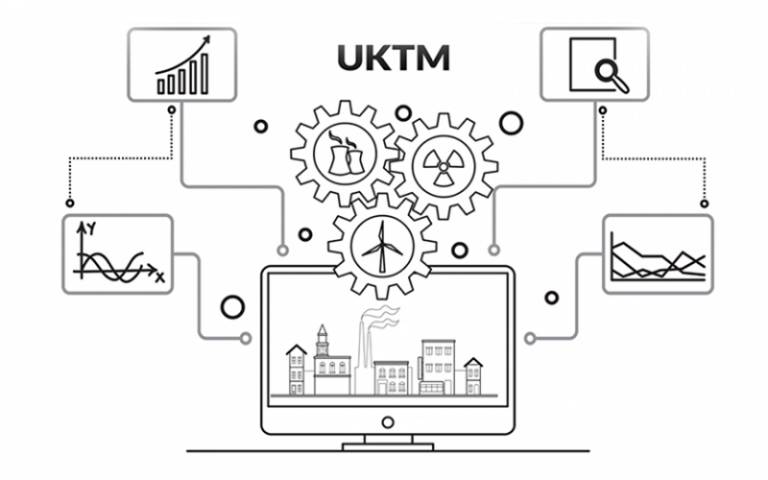Helping plot the UK’s pathway to net zero
UCL Bartlett researchers developed a model to identify which sectors of UK industry should be decarbonised first – and how fast – for the UK to cost-effectively meet its emissions targets.

28 April 2022
The UK TIMES energy system model is now used by the Department of Business, Energy and Industrial Strategy (BEIS) to determine the UK’s pathway to net zero, and it has influenced competitive decarbonisation in the industrial sector.
Exploring cost-effective routes to a low-carbon economy
With ever-increasing energy demands and a commitment to reducing the UK’s emissions to net-zero, a transformation of how we produce and use energy is needed. The cost of transitioning to a low-carbon energy system has been estimated as 1%–2% of GDP and could be higher if poor investment decisions are made.
Bartlett researchers including Professor Paul Dodds and Associate Professor Steve Pye co-designed the UK TIMES model with BEIS to explore cost-effective routes to a low-carbon economy. It simulates all UK greenhouse gas emissions and options for reducing them, and includes for the first time all emissions from outside of the energy system including those from agriculture, land use, refrigerants, and waste.
Low-carbon processes for sectors like iron, steel and chemicals are factored in, and the model also represents six key local air pollutants.
A coherent and coordinated decarbonisation strategy
The UK TIMES model and its supporting research have become the core mechanism by which BEIS is transitioning UK energy policy to net-zero emissions. The process of mapping and reviewing scenarios generated by UK TIMES has allowed specialist teams within BEIS and other government departments to create a more coherent and coordinated decarbonisation strategy.
In the process, increased cross-disciplinary working has improved communication of decarbonisation challenges in each sector of the economy between departments.
This improved cross-department working was beneficial in the development of the 2017 Clean Growth Strategy, which was underpinned by three scenarios created using UK TIMES and published by BEIS. This document sets out how the government plans to meet its Carbon Budget commitments, exploring decarbonisation pathways and opportunities for growth. The subsequent Energy White Paper has a long-term commitment to continue using the model.
Influencing global policy
The model also has broader uses. The Scottish Government adapted UK TIMES, replacing UK data with Scottish data to enable in-depth modelling of Scotland. Bartlett researchers worked with and trained National Grid employees to model scenarios for their 2018 and 2020 Future Energy Scenarios, which are used by both industry and academia.
In advance of COP21, which led to the Paris Agreement, a collaboration of researchers from 16 countries developed the Deep Decarbonization Pathways Project (DDPP), and UK TIMES was used for the first national DDPP decarbonisation assessment.
Projecting energy demands for different sectors
Further collaborations built by the Bartlett researchers helped the Climate Change Committee produce their ‘Reducing UK emissions’ report to Parliament, which identified sectors where emissions-reduction work had stalled.
Bartlett research has also helped improve the UK government’s Energy Demand Model (EDM). This model is used to project energy demands for different sectors for use in the government’s annual Energy and Emission Projections.
These projections are used for several purposes including reports to the UN Framework Convention on Climate Change, informing the Climate Change Programme, and setting carbon budgets. The EDM is also used by UK TIMES along with other data.
Using econometric modelling, Bartlett Professor Paolo Agnolucci showed that EDM projections had overestimated industrial sector energy demands. He then produced a new industrial energy demand model, which now contributes more accurate future demand projections for UK government, and UK TIMES itself.
Research synopsis
Developing the UK TIMES model to underpin the UK Government’s decarbonisation strategy
Bartlett researchers developed the UK TIMES model to identify which sectors of UK industry should be decarbonised first – and how fast – for the UK to meet its emissions targets in a cost-effective manner. The model is now used by the Department of Business, Energy and Industrial Strategy (BEIS) to determine the UK’s pathway to net zero, and it has influenced competitive decarbonisation in the industrial sector.
Links
- Professor Paul Dodds’ academic profile
- Dr Steve Pye’s academic profile
- Professor Paolo Agnolucci's academic profile
- Professor Neil Strachan's academic profile
- UCL Bartlett School of Environment, Energy and Resources
- The Bartlett, UCL Faculty of the Built Environment
- The Bartlett REF 2021
Image
- Image credit: Fred Rivett on Unsplash
 Close
Close

